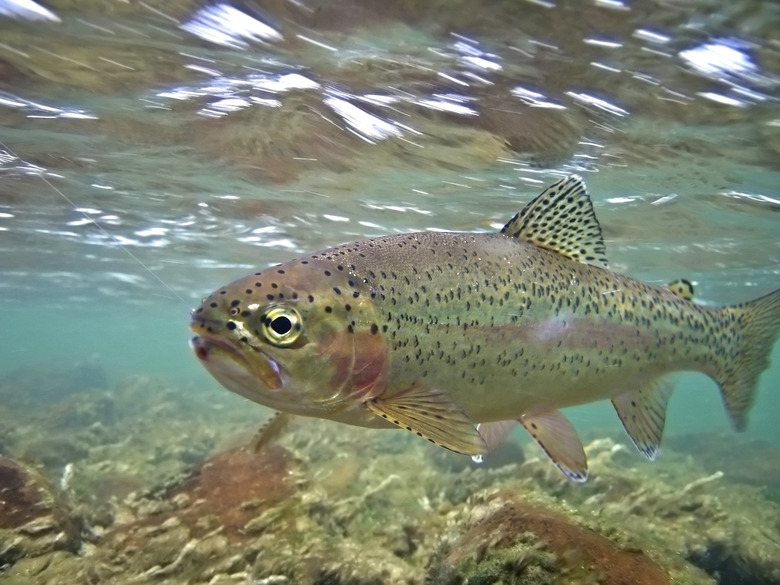Trout Fish Farming
Seafood, it's what's for dinner! As consumer demand for seafood has risen, producers have begun to rely more heavily on aquaculture – the process of raising fish and shellfish in a controlled setting. In fact, approximately 40 percent of the seafood consumed across the globe comes from fish farming operations. Every year, trout farming operations produce millions of pounds of fish.
Why Grow Farmed Trout?
Why Grow Farmed Trout?
Why should we farm fish in the first place? Oceanic populations, from fish and sharks to marine mammals, all face direct decline from overfishing. Remember that demand for seafood? Most of the seafood you eat comes from the oceans. Fishermen rely on catching seafood as a means of survival, but overfishing causes population decline of the targeted species, and other animals they aren't trying to catch often perish in their nets as well.
Trout farming provides fishermen with an alternative to catching wild stocks of fish. This allows those wild fish to reproduce and build their populations back up without as much interference. When done correctly, it also ensures a steady production of fish for the farmer, and it also allows them to spend more time at home and less time at sea away from their family.
What Is Aquaculture?
What Is Aquaculture?
Fish farming, also known as aquaculture, is the process of raising fish or shellfish in a controlled setting – typically as a source of food. Farmers can use a number of different habitats, including artificial ponds, tanks, and even pens within natural bodies of water such as rivers and streams. Fish farmers can also offer seafood at a more reasonable price, allowing them to sell greater numbers to more people.
How Does Trout Farming Work?
How Does Trout Farming Work?
In trout farming, the fish do not go through spawning, their natural reproductive cycle. Instead, fish farmers can artificially propagate the fish by removing the eggs and sperm. This process can be done without hurting the fish, allowing the fish farmer to keep their best breeding stock through multiple seasons.
The trout farmers pick the largest, healthiest fish and keep them as broodstock, or fish that they use to produce young. Farmers massage the abdomen of the female fish to remove the eggs, and they use the same process to remove the sperm (or milt) from the male fish. They then mix the milt of several males with the eggs of the female, add water, and wait until the eggs reach the eyed stage.
Eyed eggs have visible eyes from the development of the larval fish. Once the eggs reach this stage the trout farmers place them in a hatching tray or sell them to other fish farmers. They then move the young fish, known as fry, into gradually larger tanks as they grow and age. Once the fish reach two years old they are ready to sell.
Who Buys Fish From Trout Farms?
Who Buys Fish From Trout Farms?
Most trout farming operations sell their fish to restaurants and grocery stores. You can purchase a number of different forms of trout, including the whole fish, bone-in fillets, bone-out fillets, canned or smoked. Sometimes trout farming operations sell live trout for recreational purposes, such as stocking ponds for fishermen. Fishermen can catch the trout from pre-stocked ponds, enjoying the recreation of fishing and the guarantee of fish in the ponds.
What Are the Downsides to Trout Farming?
What Are the Downsides to Trout Farming?
Trout farming has a few potential downsides. The environmental impact of fish farms on the surrounding ecosystem can have unfortunate consequences. Waste products, such as feces, leftover food, dead fish and other byproducts can sometimes make their way into the local waterways. Fish raised in large numbers can also produce bacteria and parasites, which farmers treat with medications. These can also sometimes end up in the surrounding ecosystems.
The impact of fish farming varies based on the fish species and the individual farm. Monterey Bay Aquarium's Seafood Watch Program (see Resources Section) identifies rainbow trout raised in the United States as a 'Best Choice' for sustainability.
Cite This Article
MLA
Zinni, Yasmin. "Trout Fish Farming" sciencing.com, https://www.sciencing.com/about-5462808-trout-fish-farming/. 30 September 2021.
APA
Zinni, Yasmin. (2021, September 30). Trout Fish Farming. sciencing.com. Retrieved from https://www.sciencing.com/about-5462808-trout-fish-farming/
Chicago
Zinni, Yasmin. Trout Fish Farming last modified March 24, 2022. https://www.sciencing.com/about-5462808-trout-fish-farming/
